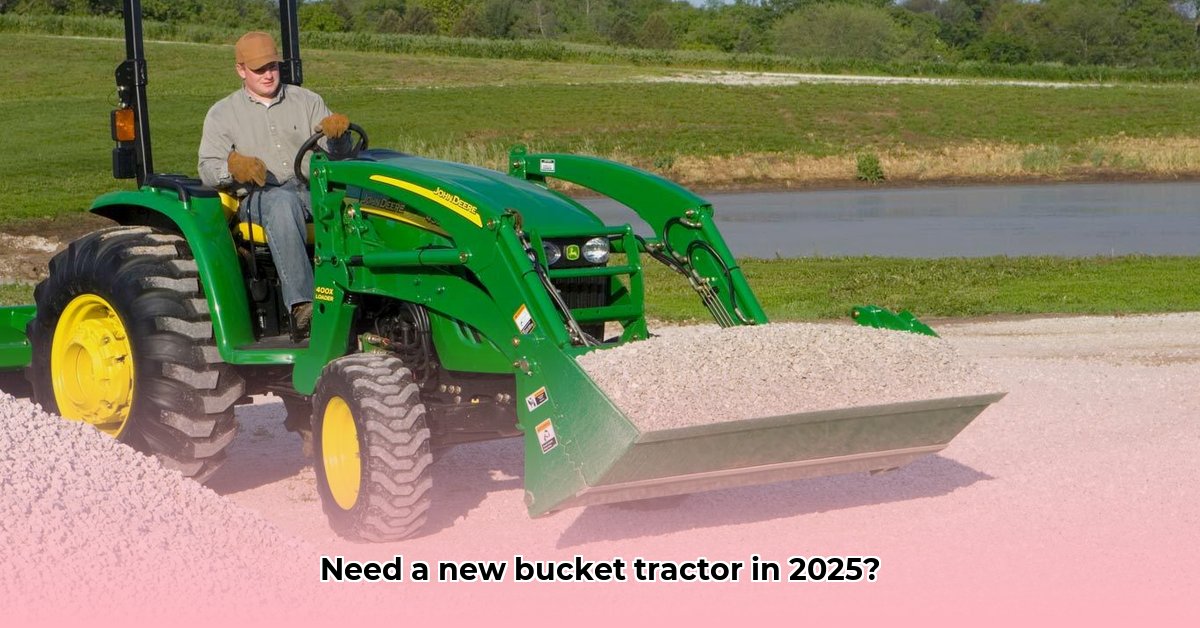
Understanding Bucket Tractor Attachments and Their Value
Bucket tractors, equipped with versatile attachments, significantly enhance farm efficiency. This comprehensive guide helps navigate the 2025 market, covering pricing, selection criteria, and long-term investment strategies. Whether you're a seasoned farmer or a newcomer, understanding these factors is crucial for maximizing your return on investment. A well-chosen bucket attachment can significantly impact your farm's operational efficiency and profitability.
Decoding Bucket Tractor Attachment Prices
The cost of a bucket tractor attachment varies greatly due to several interacting factors:
Size: Larger buckets, capable of handling greater volumes, command higher prices. Selecting a bucket appropriately sized for your tractor and typical loads optimizes efficiency and cost.
Materials: High-strength steel, such as Hardox (a type of wear-resistant steel), provides superior durability but increases the initial cost. More budget-friendly materials exist but may require more frequent replacements.
Features: Quick-attach systems (allowing for rapid attachment changes) increase convenience but add to the overall price. Carefully consider the frequency of attachment changes when assessing the value of this feature.
Brand Reputation: Established brands often command premium prices reflecting their reputation for quality and reliability. Evaluate the balance between brand recognition and potentially lower-cost alternatives.
New vs. Used: Used buckets offer significant cost savings compared to new ones. A used John Deere 66" bucket, for instance, might cost around $850, whereas a new model costs substantially more. Thorough inspection is crucial to avoid unexpected repairs.
Selecting the Optimal Bucket for Your Needs
Choosing the right bucket involves carefully considering specific operational requirements:
Size: Match bucket capacity to your tractor's lifting power and typical load sizes. Overloading can damage both the bucket and the tractor.
Material: Choose high-strength steel for demanding applications; less expensive materials might suffice for lighter workloads.
Features: Quick-attach systems are valuable for frequent attachment changes, while specialized features (grapples, forks) are beneficial for specific tasks.
Compatibility: Ensure complete compatibility with your tractor model before purchasing to avoid costly errors.
Current Market Trends and Long-Term Investment Strategies
The bucket tractor attachment market is dynamic. There is increasing demand for specialty buckets (e.g., rock buckets, tree root buckets). Improvements in durability and features like quick-attach systems are ongoing trends.
Investing in a high-quality bucket, while initially more expensive, translates into long-term savings through extended lifespan and reduced replacement costs. Regular preventative maintenance is crucial regardless of bucket type.
Stakeholder Perspectives on Bucket Tractor Attachments
Different stakeholders have varying priorities concerning bucket tractor attachments:
| Stakeholder | Short-Term Priorities | Long-Term Priorities |
|---|---|---|
| Farmers | Affordability, operational efficiency | Maximum return on investment (ROI), durability |
| Dealers/Manufacturers | Competitive pricing, innovative features | Market share growth, technological advancements |
| Parts Suppliers | Inventory management, meeting demand for common parts | Anticipating future trends, efficient supply chain management |
Potential Pitfalls and Mitigation Strategies
Understanding potential risks is key to informed decision-making:
| Risk Factor | Mitigation Strategy |
|---|---|
| Purchasing Used Equipment | Thorough pre-purchase inspection, warranty verification |
| Bucket Wear and Tear | Regular maintenance, proper storage |
| Compatibility Issues | Verify compatibility before purchasing |
Actionable Steps for Choosing the Right Bucket
- Assess Your Needs: Define the primary applications for the bucket (e.g., material handling, land clearing). This dictates the size, shape, and features required.
- Set Your Budget: Balance initial cost with long-term operational costs. Consider the trade-offs between new and used equipment.
- Choose the Right Attachment System: Decide between quick-attach (SSQA) and pin-on systems based on the frequency of attachment changes.
- Select the Appropriate Bucket Size: Ensure compatibility with your tractor's lifting capacity. Consult your tractor's manual for maximum lift specifications.
- Prioritize Material Strength: Opt for high-strength steel for heavy-duty applications. Consider the specific demands of your work environment.
- Source Your Bucket: Explore dealerships, online marketplaces, and custom fabricators, evaluating the trade-offs between cost, convenience, and specialization.
This guide provides a framework for selecting the optimal bucket tractor attachment. Remember that thorough research and careful consideration of your specific needs and budget are crucial for maximizing your investment.